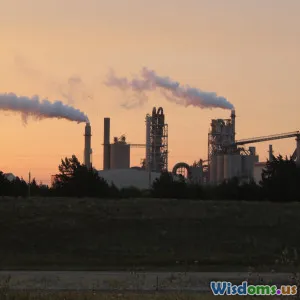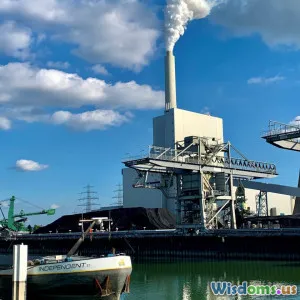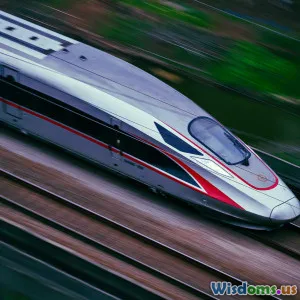
The Future of Freight Is Autonomous Trucking Good for the Air
9 min read Exploring how autonomous trucking shapes the future of freight and its environmental impact on air quality. (0 Reviews)
The Future of Freight: Is Autonomous Trucking Good for the Air?
Freight transportation powers global commerce, moving billions of tons of goods annually. Amid rising environmental concerns, a technological revolution is underway: autonomous trucking. But beyond increased efficiency and safety, can this promising innovation deliver cleaner air? This article explores how the rise of self-driving trucks is redefining the future of freight, and whether it's truly good for our planet's atmosphere.
Introduction
Freight trucking is the backbone of logistics, accounting for nearly 70% of freight movement in many countries. Its environmental footprint is significant — trucks contribute roughly 7% of total U.S. greenhouse gas emissions, a substantial portion coming from freight operations. The introduction of autonomous trucks, equipped with advanced sensors and AI, is poised not only to transform the trucking industry but also potentially reshape its environmental impact.
Curiously, could these driverless vehicles be the key allies in the fight against air pollution and climate change? Let's delve into the evidence and expert insights.
Understanding Autonomous Trucking
What Is Autonomous Trucking?
Autonomous (or self-driving) trucks use a combination of LIDAR, radar, cameras, GPS, and sophisticated machine learning algorithms to navigate roads without human drivers. The technology ranges from partial automation (Level 2 and 3, involving driver assistance) to fully autonomous operations (Level 4 and 5), capable of independent decision-making in complex environments.
Companies like Waymo, TuSimple, and Aurora are pioneering autonomous freight trucks in North America, while manufacturers such as Volvo and Daimler are innovating with autonomous systems on commercial vehicles.
The Potential Benefits of Autonomous Freight
- Improved fuel efficiency: Autonomous trucks can optimize driving patterns, eliminating human errors such as harsh braking and acceleration.
- Reduced driver shortage impacts: The trucking industry faces a severe shortage of drivers. Automation promises continuity in freight movement.
- Increased safety: By decreasing accidents caused by driver fatigue or error, there can be fewer traffic-related emissions spikes.
- Operational efficiency: Autonomous trucks can operate continuously with less downtime, optimizing delivery routes and loads.
The Environmental Impact of Freight Trucks
Emissions Overview
Heavy-duty trucks traditionally rely on diesel engines, producing pollutants such as nitrogen oxides (NOx), nitrogen dioxide (NO2), particulate matter (PM), and carbon dioxide (CO2). According to the EPA, these contribute to smog, respiratory diseases, and global warming. The average heavy-duty truck emits about 1.1 pounds of NOx per mile and thousands of pounds of CO2 annually, depending on mileage.
Air Quality and Public Health
Regions with dense freight corridors frequently suffer from worsened air quality. The American Lung Association links diesel emissions from freight to increased asthma, lung cancer, and cardiovascular diseases.
How Autonomous Trucks Could Improve Air Quality
Enhanced Fuel Efficiency and Lower Emissions
One of the critical environmental advantages of autonomous trucking lies in its potential fuel economy gains. An NREL (National Renewable Energy Laboratory) study found that autonomous trucks could improve fuel efficiency by 10-20% through optimal acceleration, deceleration, and platooning — a method where trucks drive closely to reduce aerodynamic drag.
For example, platooning can reduce fuel consumption by as much as 10% for the leading truck and over 20% for followers. Exponential improvements in fuel use directly correlate to reduced greenhouse gas emissions.
Reduced Congestion and Idle Time
Autonomous trucks equipped with connectivity can help reduce highway congestion by optimizing spacing and speed. Reduced stop-and-go traffic minimizes idling, a prime source of unnecessary emissions.
A 2021 University of Michigan study showed that freight vehicles optimized by AI-driven logistics experienced 7% less idle time, leading to meaningful emission reductions.
Lower Demand for Diesel with Electrification Integration
Many autonomous trucks are being developed alongside electric drivetrain advancements, including companies like Einride and Volta Trucks producing fully electric autonomous freight vehicles. Transitioning from diesel to electric not only decreases emissions but can radically improve air quality, especially if charged with renewable energy sources.
Challenges and Considerations
The Carbon Footprint of Manufacturing and Software
While autonomous trucking offers operational emissions advantages, manufacturing self-driving technology, sensors, batteries, and computing hardware involves energy-intensive processes. The carbon footprint of producing these vehicles can transiently offset environmental benefits.
A 2022 lifecycle analysis noted that autonomous trucks' manufacturing emissions could be 15-25% higher than conventional trucks, though the gap narrows over vehicle lifespan due to efficiency gains.
Infrastructure and Energy Grid Constraints
For electric autonomous trucks to realize their clean air potential, the energy grid must improve toward renewable sources. Otherwise, tailpipe emission benefits might be undermined by carbon-heavy electricity generation.
Furthermore, autonomous trucking demands robust digital infrastructure and smart roads, which impose additional resource and environmental costs.
Regulatory and Safety Concerns
The transition involves complex regulations ensuring safe integration of autonomous trucks into current roadways. Unexpected software failures or accidents could erode public trust and stall adoption, indirectly prolonging the use of older, more polluting vehicles.
Real-World Insights and Industry Movement
Case Study: TuSimple and UPS
In 2022, TuSimple partnered with UPS for autonomous freight operations on a 1,000-mile desert route. Early reports indicate a 15% fuel efficiency improvement and 20% reduction in transit time. UPS’s sustainability director highlighted that “these gains translate directly to lower emissions and cleaner air along logistics corridors.”
Volvo’s Autonomous Electric Trucks
Volvo Trucks launched an electric autonomous truck, engineered for local freight deliveries, targeting urban pollution reduction. Initial deployments in Gothenburg, Sweden, have showcased 0% local emissions and quieter operations, supporting city air quality goals.
Government Initiatives
Governments are increasingly balancing the growth of autonomous freight with environmental impact frameworks. For instance, the European Union’s Green Deal prioritizes electrification and automation in freight to cut emissions 55% by 2030.
Conclusion: Autonomous Trucking’s Role in Cleaner Air is Promising but Complex
Autonomous trucking represents a transformative leap in freight transport. The technological enhancements—including fuel optimization, platooning, 24/7 operation, and integration with electric powertrains—can deliver significant air quality benefits by reducing greenhouse gases and harmful pollutants.
However, realizing these environmental advantages demand holistic consideration of energy sources, manufacturing impacts, infrastructure readiness, and regulatory frameworks. Public-private partnerships and continued innovation will be essential to maximize benefits while mitigating drawbacks.
Ultimately, the future of freight is autonomous—and with conscientious development, it can drive us toward a greener, cleaner atmosphere.
Call to Action:
- Businesses should invest in autonomous and electric freight technologies.
- Policymakers must create incentives for clean, automated freight solutions.
- Researchers should further evaluate real-world environmental impacts.
By embracing intelligent, sustainable freight innovations, we can ensure autonomous trucking doesn't just revolutionize logistics but helps us breathe easier too.
For further reading:
- National Renewable Energy Laboratory reports on autonomous vehicle efficiency
- EPA’s data on heavy-duty truck emissions
- Industry updates from TuSimple, Volvo Trucks, and UPS autonomous projects
Rate the Post
User Reviews
Popular Posts




















